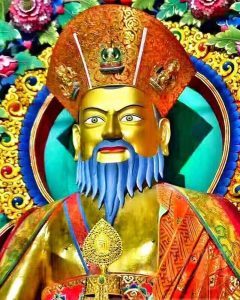Emergence of a Nation State
Zhabdrung Ngawang Namgyal
and Desis
Nation State:
- It
refers to the people living within a fixed territory under a certain government
with common language and cultural heritage.
Zhabdrung Ngawang Namgyal and Desis:
ü Zhabdrung arrived in Bhutan in 1616.
ü He overcame the obstacle with Lam Khag Nga and Five Tibetan Invasions.
ü he united western Bhutan under the Drukpa rule
by 1651
ü He introduced laws, festivals, administrative
system, monastic system, culture and tradition.
ü After Zhabdrung Ngawang Namgyal, 55 Desis
ruled Bhutan.
ü Zhabdrung and the Desis therefore safeguarded
Bhutan’s sovereignty.
Contributions of Zhabdrung Ngawang Namgyal:
i)
He
united Bhutan.
ii)
He
established Choesid Nyiden.
iii)
He
codified laws.
iv)
He
created our unique identity.
i)
He United Bhutan:
ü In unifying the Bhutan, Zhabdrung faced five
Tibetan invasions (external oppositions) and Lam Khag Nga (Internal
Oppositions) who were attempting to establish their influence in Bhutan.
ü In pursue of his dream the descendants of Phajo
Drugom Zhigpo, Drukpa Kuenley and Drupthop Ter Khugpa became his main
supporters.
·
First Tibetan Invasion in 1617:
ü This was by Tsang Desi Phuntsho Namgyel to
destroy Zhabdrung.
ü However, The Pazaabs, the first Bhutanese
militia led by Tenzin Drugdra and Zarchen (Chhoeje Dorji Gyalpo) defeated the Tibetans at Chang Nangkhatse, Paro.
·
Second Tibetan Invasion in 1634:
ü Lam Khag Nga dragged Tibetans into conflict
second time after they had been defeated earlier by Zhabdrung.
ü They targeted from six fronts, two in Paro/one
in Goen/one in Cheri/one in Nyingla and one in Bumthang.and they were defeated
and Lam Khag Nga’s forces greatly weakened.
·
Third Tibetan Invasion in 1639
ü The third Tibetan invasion was again initated
by Lam Kha Nga who were unhappy with the
growing power of Zhabdrung Ngawang Namgyal and they planned to seize Punakha
Dzong.
ü Tibetan and Lam Khag Nga’s army were unsuccessful
to seize the Punakha Dzong so from there an agreement was signed between the Zhabdrung and Tsang Desi Karma Tenchong Wangpo.This agreement recognized
Zhabdrung as the Supreme Authority
of Bhutan.Cooch Bihar, Nepal and Ladakh
sent goodwill messages to Zhabdrung.This increased the pristine and popularity
of Zhabdrung.
·
Fourth Tibetan Invasion in 1644:
ü Tibetan and Mongol army marched to Bumthang an
launched an attack from Lhodrak
ü They lost many weapons and arms to the
Bhutanese. So they were defeated.
·
Fifth Tibetan Invasion in 1648 – 49:
ü The combined forces of the Tibetans and
Mongols army marched till Paro, Thimphu and Punakha.
ü They were defeated again.
ü To commemorate the victory and to show his
gratitude to the protective deities, Punakha
Dromchoe was instituted.
ü He built Dzongs
in each region to symbolize the seat of Drukpa
Supremacy.
After Fifth Tibetan Invasion:
· Zhabdrung went into strict/permanent retreat.
· At the time of his retreat, Bhutan was not
completely unified because only western part was unified.
· Before his retreat, he invested the
responsibility of completing the unification of eastern Bhutan, Sharchog Khorlo
Tsibgye under the Drukpa rule by instituting the post of Choetse Poenlop
· Only in 1655 the whole of eastern Bhutan was
unified under the Drukpa rule.
· The urgency of creating a Nation State was
also injected in his supporters by Zhabdrung.
ii)
He established Choesid Nyiden.
Before
he entered into the retreat in 1651, he established a political setup known as
Choesi Nyiden to suit the need of the time and the Bhutanese.
This
system is also known as Dual System of Governance.
This
system had also two persons to look after temporal and spiritual affairs in the
absence of Zhabdrung.
This
system continued till the hereditary monarchy in 1907.
Desi managed the temporal
while Je Khenpo managed spiritual affairs.
Desis- Head of Political Affairs.
ü The country was divided into three provinces,
Paro, Dagana and Trongsa.
ü Paro Poenlop looked after west and southern
Bhutan.
ü Dagana Poenlop looked after south and central
parts of Bhutan.
ü Trongsa Poenlop looked after the eastern part
of Bhutan.
ü Paro, Dagana and Trongsa Poenlop were known as
Chog gi Chila Namsum – Three Regional Monastic Superintendents.
ü The First Chilas were Trongsa – Minjur Tenpa, Dagana –Tenpa Thinley and Paro – Tenzin Drugdra.
ü Thimphu, Punakha and Wangdiphodrang Dzongs
were headed by Dzongpons,
ü Thimphu, Punakha and Wangdiphodrang Dzongs
were known as Densa Zhungsum (three Central Seats).
ü These three Dzongs had equal status with Chila
Namsum.
ü Punakha and Thimphu Dzongs together were
called Densa Phantshun (Alternative Monastic Seats).
ü The First Three Dzongpons of Densa Zhungsum
were:
i)
Wangdiphodrang
– Namkha Rinchen.
ii)
Thimphu
– Au Tshering.
iii)
Punakha
– Pekar Rabgye.
ü Other Dzongpons were under the control of
Chila Namsum.
ü Dzongs were assisted by Drungpas and Gups.
iii)
He Codified Laws:
·
One of
the greates achievement of Zhabdrung was the
codification of laws known as KATHRIM.Kathrim
was written down only in 1729 by 10thJe
Khenpo Tenzin Choegyal.
·
The
Kathrim brought order in the system and protested people from exploitation and
harassment and minimized corruption as well as social problems.
·
Under
Kathrim, Zhabdrung defined the responsibilities of a Desi. For example, Inter Alia (Justice, Peace and Security
to the public and country and to support the monastic body)
·
The
institution of laws also established relationship between the monastic
community and the people for instance the monks performed prayers and rituals
for the community while the latter provided material support to the former.
·
Zhabdrung
also maintained the Sathram in the Dzongs to ensure the continuity of this rapport.
·
The
payment of the tax was also streamlined.
·
The
public had to contribute compulsory labour(woola) besides tax in kind.
IV.He Created our Unique Identity:
·
Zhabdrung
realized that the lack of national identity in Bhutan is the biggest threat to
the Bhutanse sovereignty because there were linguistic variety, dress code,
food habits, religion, architect, etc.
·
He
introduced the ceremony of Zhugdrel Phuensum Tshogpa after the completion of
Punakha Dzong which is a special feature special in Bhutan. This ceremony
symbolizes the Bhutanese Nationhood and Unity amongst different valleys.
·
Dzongs
which were built under his command represented strength, which safeguarded the
Bhutanese Sovereignty from internal and external threats.
·
Dress code
as (Gho and Kira),festivals and even rituals are other unique features created
by Zhabdrung
DESI
Introduction
-
Bhutan
was ruled by 55 Desis between 1651 to 1907.
-
13th
Desi ruled for 19 long years
-
38th
Desi wangchen Gyalpo rulled for only few months
-
Desi
Dorji Norbu and Desi Tashi Dorji rulled jointly as 36th Desi
Modalities of becoming a Desis were:
i)
Appointment by Zhabdrung Ngawang Namgyal.
ü Zhabdrung himself appointed only Umze Tenzin Drugyal directly as the
first Desi to look after the temporal affairs of the Drukpa State.
ü Later, Third Desi Chhoegyal Minjur Tenpa and
some other Desis were appointed through the Letter bearing the seal of
Zhabdrung Ngawang Namgyal by the Monastic Body and the Lhengye Tshog.
ü The candidate took oath in Punakha Dzong. This was done to keep the death of Zhabdrung
Ngawang Namgyal secret from his enemies.
ii)
Appointment by Monastic Body:
ü 20th Desi Umze Chabchap, 31st
Desi Tenzin Drugdra, 48th Desi Tshenlop Tsondue Pekar and 49th
Desi Jigme Namgyal were appointed by the Monastic Body.
ü Monastic Body appointed the people who supported
monastic system and benefited the public.
ü It even led to coup-d’etat when the reigning
Desi was in favour of the monastic body
iii)
Appointment by Powerful and Influential
Individuals:
ü Jigme Singye, the incarnation of Gyalse Jampel
Dorji appointed 17th Desi.
Jigme Namgyel appointed 15th Desi Kitselpa Dorji Namgyel.
ü 52nd Desi Lam Tshewang and 53rd
Desi Gawa Zangpo were appointed by the people of Jigme Namgyel.
ü 54th Desi Yanglop Sangay Dorji and
55th Desi Chhodtruel Yeshey Ngoedup were appointed by Ugyen
Wangchuck.
iv)
Self-appointment through assassination and
force:
ü 6th Desi Ngawang Tshering
assassinated 5th Desi Gedun Chhophel and took the post.
ü Druk Rabgye became the 8th Desi
after assassinating Punakha Dzongpon Tenpa Wangchuk, Je Kuenga Gyeltshen and
all the supporters of Tenpa Wangchuk
including Terteon Drukda Dorji.
v)
Appointment through coup d'état:
ü When Druk Rabgye, 8th
Desi refused to recognize the incarnation of Je Kuenga Gyaltshen as Zhabdrung,
he was thrown in Pachhu below Paro Dzong by Monastic Body.
ü The Monastic Body
appointed Ngawang Gyamtsho as 9th Desi, later he appointed his
candidate Lama Chogyal Namgyal in the
post of the Zhabdrung. So Monastic Body
launched coup d'état again and appointed Mipham Wangpo as 10thDesi.
Contributions
of Desis:
i)
Religious Reforms:
ü La Ngoenpa Tenzin Drugdra, the 2ndDesi
built Eight Stupas of Red Sandalwood
inside Punakha Dzong known as Nguelbum
Choeten.
ü 3rd Desi renovated Simtokha Dzong
and inscribed the images of Lord Buddha and the Buddhisittvas on the slate.
ü Tenzin Rabgye established the Tshengyi Dratshang or the debate
Monastery and he made compulsory for each family having three sons to send one
as monk.
ü 6th Desi Ngawang Tshering brought
Tenjur and “Kanjur in gold’ from Tibet and erected a three storeyed golden
statue of Buddha Amitabha in Tashichho Dzong.
ü Druk Namgyel made many printing books in
Punakha Dzong and helped in the production of religious books and enhanced its
circulation availability to promote Buddhism
ii)
Institution of Laws:
ü First Desi
Umze Tenzin Drugyal introduced new laws called Mitong (Fine for murder, theft, illegal weighing unit).
ü He formulated Bhutanese code of conduct called
Driglam Namzha based on sixteen
human principles and ten divine virtues as the law of the country to promote
values in the society.
ü The other Desis practiced it for peace and
order of the Nation.
iii)
Educational Reforms:
ü 2nd Desi introduced the study of
medicine, art, sculpture and literature in the monastic school.
ü Fourth Desi introduced 13 crafts called Zorig
Chusum.
iv)
Political Security:
ü 2nd Desi constructed Drugyal and
Paro Ta Dzong.
ü 3rd Desi brought Khorlo Tsibgye
under the Drukpa rule.
ü 3rd Desi constructed Trongsa,
Jakar, Trashiyangtse, Zhongar, Zhemgang and Dungsam Dzong.
ü 8th Desi solved the
Tibeto-Bhutanese border problem.
ü Desi Kuenga Rinchen and Jigme Singye extended
Anglo-Bhutanese relationship.










3 Comments
instagram takipçi satın al
ReplyDeletecasino siteleri
sms onay
günlük kiralık ev
sanal ofis
SAWKU
instagram takipçi satın al
ReplyDeletecasino siteleri
sms onay
günlük kiralık ev
sanal ofis
WAG
instagram takipçi satın al
ReplyDeletecasino siteleri
sms onay
günlük kiralık ev
sanal ofis
NBP